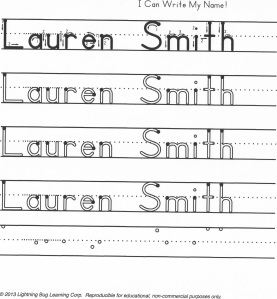I Can Write My Name!
Learning to write your own name is a big deal in the kid world! It means that youʼre
growing up and getting ready for school. Youʼre old enough to be trusted with writing
tools such as pencils, pens, and markers. You can use that neat looking paper with lines
on it. Names represent ourselves, so naturally itʼs a highly desired skill in the eyes of a
child.
Now where to begin helping your child learn to write his or her name? In my opinion, itʼs
best to teach name writing correctly from the start by using an upper case letter at the
beginning of the name, followed by lower case letters. As students enter kindergarten,
many have to be retrained because they were taught in preschool to print using all
upper case letters. While lower case letter formation may not be as easy as connecting
straight lines, itʼs less frustrating for children to learn correctly from the start.
Here are tips to keep in mind when creating materials to teach name writing and
name recognition:
1. Begin with only the first name. After the first name has been mastered, teach the last
name as well.
2. Model name writing that begins with an upper case letter and is followed by lower
case letters.
3. Find out if your local school district uses print or DʼNealian styles of manuscript. Use
that type of writing to ease your childʼs transition into elementary school.
4. Use a larger font when creating materials for tracing.
5. Purchase a chubby primary pencil, or use a pencil grip to encourage proper pencil
grasp.
6. Initially, you may want to place a star or sticker on the left side of the paper to remind
your child to start on the left. Itʼs not uncommon for young children to attempt to write
from right to left.
Some helpful materials to create for these exercises:
1. Laminate a sentence strip with the childʼs name printed in a black marker. Sentence
strips can be found at teacher supply stores (who may also supply laminating), or at adollar store. Children can practice tracing using a wet-erase marker such as Vis-a-
Vis. Wipe clean with a baby wipe or rinse under water for reuse.
2. Create a sentence strip puzzle. Print the name in a black marker. Cut the name
apart into puzzle-like pieces (one piece per letter). Laminate or seal using clear
Contact paper and recut. Place pieces in a zipper baggie. Children can practice
putting the letters of their name in order.
3. Design a tracing worksheet using teacher font software. Use a large font to begin
with. Make one line with solid letters as a model. Make a second and third line with
dot-to-dot letters for tracing. Leave a blank line for children to practice independently.
These sheets can also be laminated, but itʼs helpful for children to practice using
pencil as well. Pencil creates more friction against paper than marker.
1. Hide pieces of the name puzzle around the room and play a name hunt game. How
many letters are your looking for? Find them all, name the letters, and build the
name.
2. Build the name using play dough, modeling clay or Wikki-Stix. Make a crayon
rubbing over the Wikki-Stix.
3. Build the name using magnet letters on the refrigerator or cookie tray.
4. Build letters out of bread dough and bake. Yum!
5. Print with fingers (the index and middle fingers together) using finger paint and paper,
or shaving cream on a tray.
6. Paint the name on an easel (this promotes the top to bottom motion necessary for
printing). Sign his name at the bottom of artwork.
7. Together, make a name plaque to hang in your childʼs room.
8. Your child can sign his own name at the bottom of thank you cards.
9. Print your childʼs name in large letters, using a Sharpie marker on a piece of colored
construction paper. Teach your child how to trace the letters using a thin line of liquid
white glue (school glue). Cover in glitter and let dry.
10. Make a simple word search and have your child look for his name. How many times
was it hidden?
With each experience your child will gain self-confidence and skill. Keep the activities
varied, short, enjoyable, and engaging. If you stop while your child is still amused, he
will be eager to practice again next time. Keep learning fun!
- Posted in: Reading ♦ Writing
- Tagged: D'Nealian, name games, name recognition, name writing, name writing activities, print
